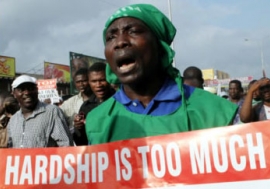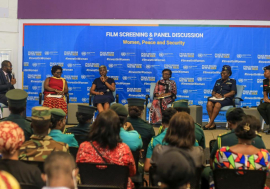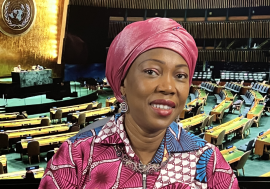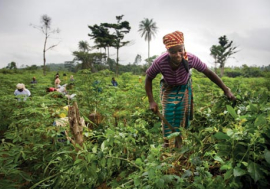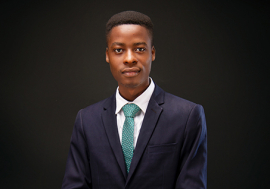Fighting African poverty, village by village
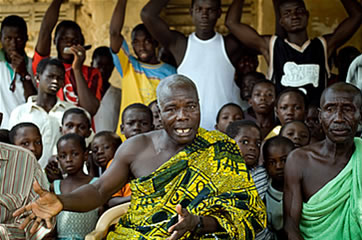 Nana Dapaah Siakwan, a village chief: Community organizations and the support of traditional leaders will be essential for ensuring the sustainability of the project when outside funding declines.
Nana Dapaah Siakwan, a village chief: Community organizations and the support of traditional leaders will be essential for ensuring the sustainability of the project when outside funding declines.Standing in the midst of a freshly planted maize field, Bright Osei Kwaku recalls that last year he more than doubled his output with the help of improved seeds, fertilizer and advice on farming techniques. Altogether, his two to three acres yielded about 15 100-kilogramme bags of maize, compared with just six bags the year before, when he had no such support.
Many other young Ghanaians have either left agriculture or dream of doing so. But Mr. Kwaku, now 25 years old, thinks he can stay on the land. “I will continue to farm,” he told Africa Renewal. “I got income and food. I got enough from the farm.”
With world food prices rising, it is a good time to push for higher production, argues Isaac Kankam-Boadu, the agriculture and environment facilitator of the Millennium Villages Project in Bonsaaso, a cluster of poor and remote settlements in Ghana’s Ashanti Region. “The high food prices are an opportunity,” he says. “The farmers can earn more money.”
Last year, Mr. Kankam-Boadu reports, Bonsaaso’s maize farmers managed to quadruple their yields from an average of about one tonne per hectare (two and a half acres) to four tonnes. Besides boosting their own incomes, the farmers contributed about a tenth of their crop to the area’s new school feeding programme, which helps many of the area’s children.
Millennium Villages
Such linkages are at the heart of the Millennium Villages Project. The first Millennium Village was launched in 2004 in Sauri, Kenya, as an integrated development initiative. Besides Ghana, the project soon expanded to also include villages in Ethiopia, Malawi, Mali, Nigeria, Rwanda, Senegal, Tanzania and Uganda. The sites were selected on the basis of their poverty indicators and to represent Africa’s different ecological and climate zones. Altogether, more than 400,000 people now live in villages chosen for the project.
The idea grew from research and policy deliberations of the Millennium Task Force, directed by the UN Secretary-General’s special adviser on the Millennium Development Goals (MDGs), Jeffrey Sachs. The MDGs, adopted by world leaders in 2000, strive to drastically reduce poverty and deprivation around the world.
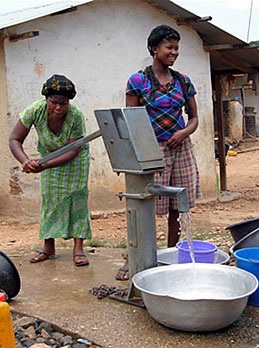 Expanding access to clean water is one of the goals of the Millennium Villages Project.
Expanding access to clean water is one of the goals of the Millennium Villages Project.The Millennium Villages approach is based on two central ideas: The first is that simple and inexpensive changes in nutrition, health, water, sanitation, education, women’s status, agriculture, communications, roads and electricity can lift rural Africans out of severe poverty. The second is that a combination of community mobilization, government support and external aid can fund these efforts for only about $110 per person per year. Most of the Millennium Village projects are being implemented by the UN Development Programme (UNDP).
Initial funders included the government of Japan, which gave more than $9 mn, and the US-based financier and philanthropist George Soros, who gave $5 mn. On 13 March, the Japanese government decided to extend its assistance by an additional $11.4 mn.
Japan’s assistance to the project is part of that country’s wider programme of support for Asia-Africa cooperation, known as the Tokyo International Conference on African Development (TICAD). The fourth conference was held in Yokohama, Japan, on 28–30 May, and was attended by Ghanaian President John Kufuor and nearly 40 other African heads of state (see article). Near the top of TICAD’s agenda was achievement of the MDGs, which is also central to the New Partnership for Africa’s Development (NEPAD), Africa’s own blueprint for economic, social and political progress.
From school meals to cell phones
The Millennium initiative came to Bonsaaso in March 2006, initially in 10 localities. By the end of that year the project had expanded to 30 communities, covering some 400 square kilometres and affecting more than 30,000 people. The area was selected because many residents were very poor, malnutrition was common, there were few health services, many children did not go to school and numerous other indicators of human development lagged.
Rather than focusing on just one or two sectors, the project’s designers want to show that poverty can be attacked across a wide front. If successful here and in other countries, says Sam Asare Afram, the Millennium Village manager in Bonsaaso, the project could provide a “model” for the continent.
Although the project is only two years old, communities in Bonsaaso are already enjoying real results. Rita Adjei, head nurse at the health clinic in Watreso, says that the new anti-mosquito bed nets mean that fewer children get malaria, although diarrhoea is still a serious problem caused by a lack of clean water and sanitation. She points to a bank of solar-powered chargers for cell phones, donated by Sony Ericsson. Once the Bonsaaso area comes under better cell phone coverage, Ms. Adjei and her assistant nurses will be able to quickly obtain better information and advice for their patients.
Nana Dapaah Siakwan, the traditional chief of Aboaboso, estimates that enrolment in the local primary school has increased from 200 to 500, largely thanks to the school feeding programme that began in March 2007. There also is a new health clinic. Until it opened, seriously ill patients had to be carried many kilometres along forest paths to a distant clinic—on a tabletop, since there was no stretcher, explains the chief. Now, he adds, “We have seen the benefits.”
Mohammed Salifu, a cocoa farmer, produced nine 64-kilogramme bags in 2007, up from just four the year before, simply by following the advice of an agricultural extension officer sent to Bonsaaso by the Ministry of Food and Agriculture. With new seedlings of a higher-yielding and faster-growing variety of cocoa, he hopes to do even better this year.
Bigger cocoa and food harvests will bring new challenges, however. The abysmal state of the roads within Bonsaaso and with other parts of Ghana makes it hard for farmers to get their crops to market. But Chinese road contractors hired by the government are busy at work, and the project has acquired two five-tonne trucks to help transport produce. Developing physical infrastructure is not one of the MDGs, notes Ernest Mensah, a project facilitator. “But if you want to eradicate poverty,” he adds, “you need infrastructure.”
Avoiding dependency
Critics of donor-aided development projects in Africa point out that they often tend to make the beneficiaries dependent on outside assistance, and frequently collapse if that money eventually dries up. The Millennium Villages Project does rely on significant inflows. On average, about 60 per cent of project financing comes from donors, 30 per cent from national and local governments and the rest from the communities themselves.
In part, the project is designed to convince donors to provide more financing over the long term, by demonstrating concretely that aid can be used effectively to reduce poverty. A careful tally is kept of every dollar spent in Bonsaaso and other Millennium Villages, not only to avoid waste and inefficiency, but also to demonstrate to donor governments that simple interventions can make a real impact. “They don’t know how practical the solutions are,” says Mr. Sachs, referring to donor agencies. “They don’t realize that at very low cost — just a few dollars — you can save children’s lives.”
By showing that external aid can indeed be effective in Africa, Mr. Sachs and his colleagues hope to convince the major industrialized countries to live up to their commitments. The 2005 summit meeting of the Group of Eight industrialized countries, for example, pledged to provide Africa with about $50 bn in aid annually by 2010 — still about twice what donors are giving so far.
To help guard against local expectations that such outside assistance will continue to keep the Millennium Villages functioning, project planners stress that certain forms of aid will be steadily reduced and that governments and villagers will need to take up a greater share of the cost. The new higher-yielding cocoa seedlings provided to farmers are currently subsidized, notes Mr. Kankam-Boadu. But as farmers earn more from their cocoa sales, by next year the subsidies will begin declining, “to let them know the realities of the market.”
Similarly, health care in Bonsaaso’s new clinics is free for the time being, to encourage poor villagers to use their services. But, explains Mr. Afram, free care is not sustainable over the long term. Project workers therefore are helping villagers sign up for Ghana’s national health insurance scheme.
In various ways, project organizers are encouraging national and local government bodies to expand their presence in Bonsaaso: by building roads, extending electricity connections and sending in more teachers, health care workers and agricultural extension advisers.
Building up community institutions and a spirit of self-help are also vital for long-term sustainability. Local residents regularly participate in the construction of new schools, teachers’ quarters, clinics and community centres by providing labour and contributing sand, stones, timber and other construction materials.
The project employs several “facilitators” to help strengthen school management committees, parents’ associations, water committees and other bodies, and to engage traditional chiefs, who play a major role in mobilizing people. Stephen Antwi, the project’s community development coordinator, told Africa Renewal that community structures will help Bonsaaso keep developing even when outside aid eventually falls. “We’ll likely have the capacity for many years.”









